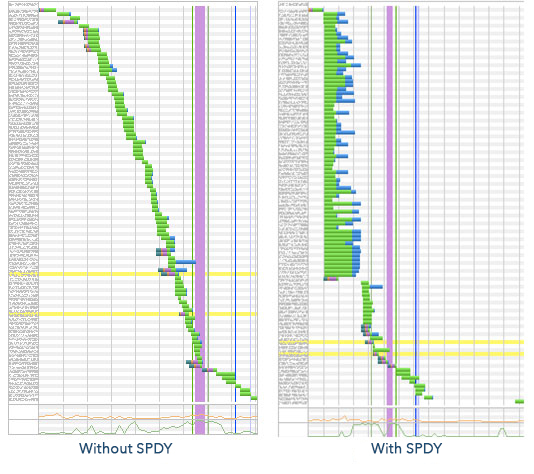In 2009, Google unveiled its SPDY project: a new protocol to reduce web page loading time by optimizing files transfers and ordering them according to their priority. With this new protocol, files are sent in a single connection (known as multiplexing).
SPDY was used as basis for the HTTP/2 specifications that were released this month (on February 18).
What is SPDY?(pronounced speedy)
This new protocol:
- compresses headers of requests and responses (unlike HTTP 1.1). The bandwidth is saved because similar headers (e.g. cookies) are not sent multiple times.
- enables multiple, simultaneous multiplexed requests over a single connection:
- we save initiating multiple connections between the client and the server.
- requests are performed simultaneously by the browser. We don’t wait anymore for a response to send another request and a low priority resource (eg an image) won’t block a higher priority resource (such as CSS).
- actively pushes resources from the server to the client that it knows the client will need (e.g. JavaScript and CSS files) without waiting for the client requests.
SPDY is deployed on Fasterize
Waiting for the application of HTTP/2, we decided to deploy (by default) SPDY. This feature will be beneficial to Chrome, Firefox, Safari and Opera users and will impact the majority of Android and iOS users.
At this moment, our customers do benefit from this new feature.
Only the push server is not yet included. It will come in the coming weeks.
With this half-way step, websites we optimise smoothly begin their transition to HTTP/2 (which will arrive in the Fasterize engine in the coming weeks). Moreover, HTTP and HTTPS page already load faster, without any further modification.
What’s the effect of SPDY on your website?
Impacts of this new feature are impressive.
As you can see below, these 2 waterfalls show the browser behavior with and without SPDY.

As we can see, SPDY and HTTP/2 allow the parralel download of resources. In this case, we save a significant time on the loading time and on the Speed Index (about -13% on the loading time and -30% on the Speed Index).
And what about you? Are you willing to easily speed up your website with SPDY?